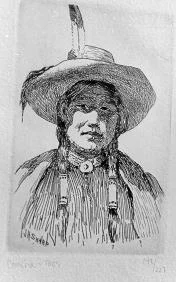Joseph Henry Sharp
1859-1953
Throughout his life, Joseph Henry Sharp was dedicated to the arts. His passion for painting seemed to have no limits as he captured the landscape and history of the West with a tremendous and impressive repertoire of paintings.
The son of a merchant, Sharp was born in Bridgeport, Ohio. He became interested in art at an early age. Though orphaned at 13 and deaf by late childhood, his indomitable spirit allowed him to pursue his artistic studies in Cincinnati and in Europe. He became both technically proficient and, as many critics came to note, capable of portraying the humanity and spirit of his subjects.
A painting commission from Harper's Weekly followed an early trip to the West in 1892. Sharp marveled at the incredible landscapes, unique cultures, and vanishing ways of life. While later studying in Paris, he regaled fellow students Ernest Blumenschein and Bert Phillips with tales of Taos, directly influencing and inspiring their voyage west.
Sharp's accuracy in portraiture and attention to details make his work prized for their ethnographic authenticity and beauty alike. Theodore Roosevelt was so impressed with his talents that he had his Indian Commission build Sharp a studio at the Crow Agency near Little Big Horn, Montana, in 1901. Many of the over 200 portraits and scenes created there are now in public institutions, including the Smithsonian Institution in Washington, D.C. He won the Gold Medal at the Panama-California Exposition in 1915 and was a member of Salmagundi Club, the Society of Western Artists and the Artists' Guild of Chicago.
Sharp spent summers in Taos from 1902 until his permanent move there in 1909. He became known for his Taos Indian portraits, genre scenes, and especially firelight themes. For the next five decades, he created a vast body of work that has become integral in understanding the Taos experience. Sharp's dedication to his work inspired the eventual creation of the Taos Society of Artists in 1915. His bright, clear colors and incredible accuracy have left a memorable and vivid Southwest legacy.
Actively seeking works by Joseph Henry Sharp.



